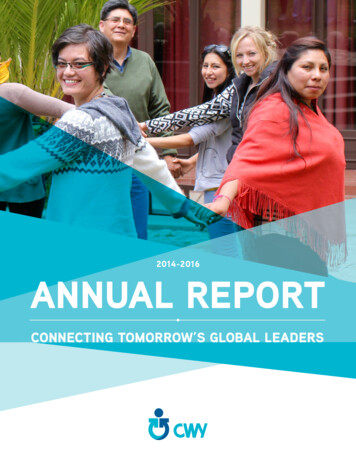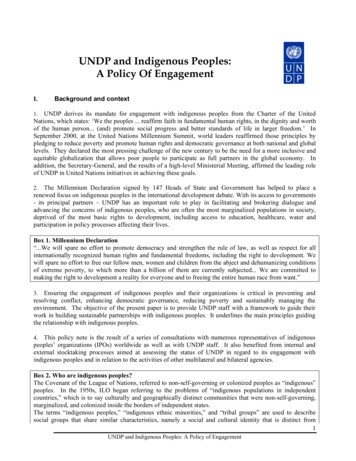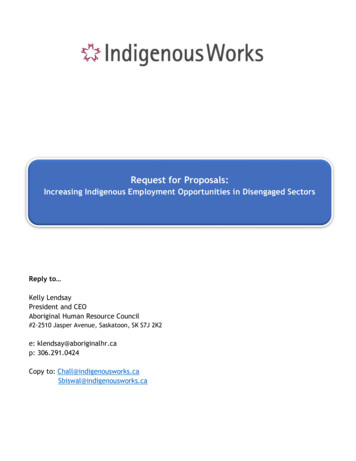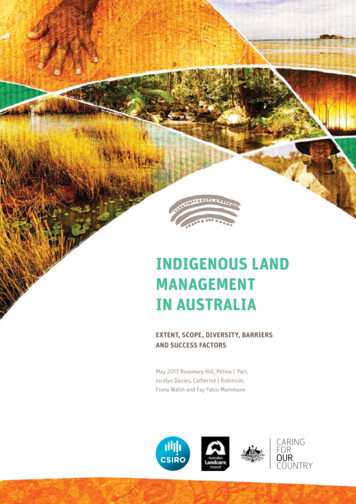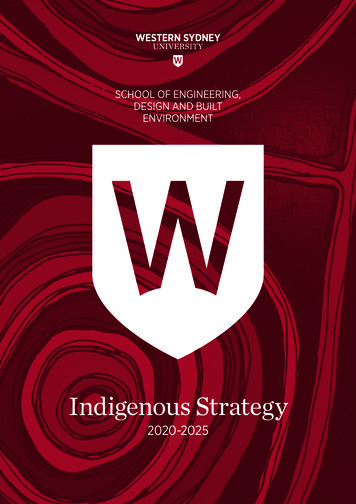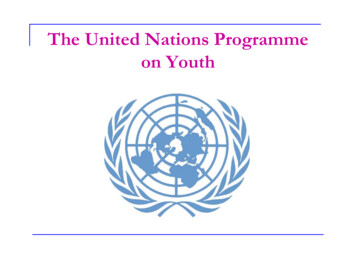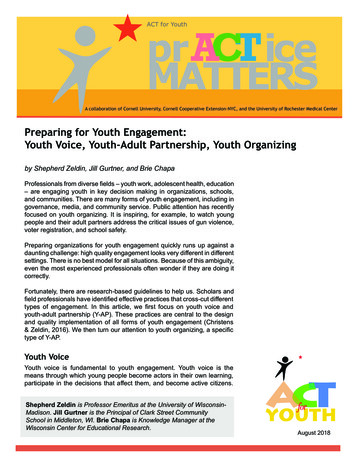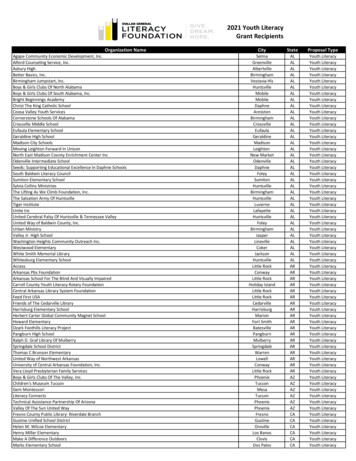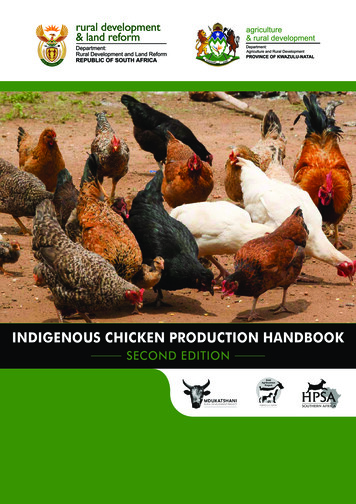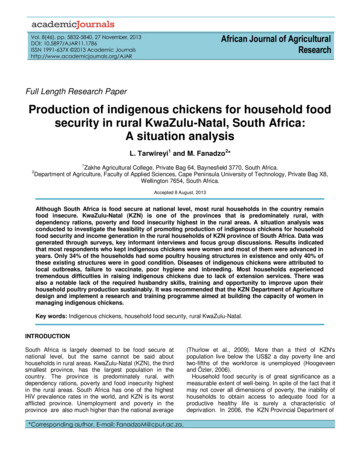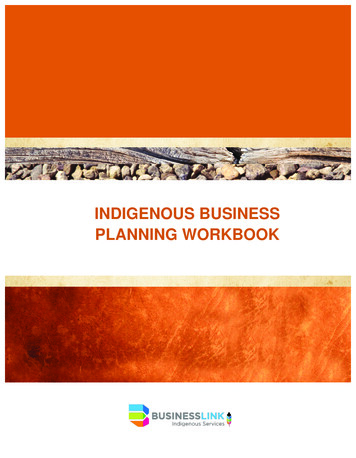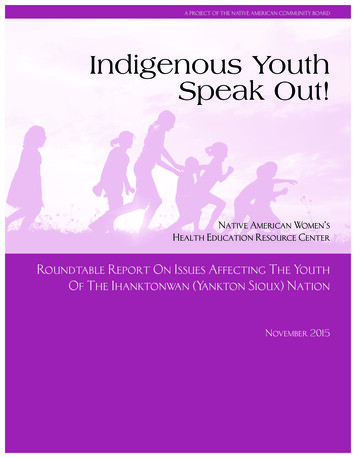
Transcription
A PROJECT OF THE NATIVE AMERICAN COMMUNITY BOARDIndigenous YouthSpeak Out!Native American Women’sHealth Education Resource CenterRoundtable Report On Issues Affecting The YouthOf The Ihanktonwan (Yankton Sioux) NationNovember 2015
AcknowledgementsThank you to the funders that made this project possible.The Frontier FundNoVo FoundationFord FoundationA special thank you to Donna Haukaas the staff member that organized the project and facilitated theservice providers dialogues and to Cecilia Petit the Intern that facilitated the youth groups.All were involved in the writing and editing of the report.Also “A thank you to the Boys & Girls Clubs of the Missouri River Area for hostingsome of our dialogs in Marty, South Dakota”.Copyright 2015 Native American Community Board. All rights reserved.Native American Women’s Health Education Resource CenterP.O. Box 572 Lake Andes, South Dakota 57356-0572(605) 487-7072 Fax (605)487-7964 email charon@charles-mix.comWebsite www.nativeshop.org2NATIVE AMERICAN WOMEN’S HEALTH EDUCATION RESOURCE CENTER
Indigenous Youth Speak Out!Roundtable Report On Issues Affecting The Youth Of The Ihanktonwan (Yankton Sioux) NationTable of ContentsCredits. page 2Introduction . page 4Participants . page 5Methodologies . page 5Issues Presented:Overview. page 6I. Violence/Drug Abuse . page 6II. Reproductive/Sexual Issues . page 8III. Exhibiting Internalized Oppression/Copingwith Hardship . page 11Recommendations and Solutions . page 12A PROJECT OF THE NATIVE AMERICAN COMMUNITY BOARD3
Introduction By Charon Asetoyer, MAThe Native American Community Board is based on theYankton Sioux Reservation in Lake Andes, South Dakota andhas been serving Indigenous women and families for almost30 years. It is headquartered in the Native American Women’sHealth Education Resource Center, which provides direct servicesto the communities including work on policy issues that improvethe health and well being of Native women and their families.One of the most recent projects of the organization is theKDKO 89.5 FM radio station. To better meet the programmingneeds of our youth, a series of youth dialogues were convenedin order to hear what they felt are important issues affectingtheir lives on a day-to-day basis.The following is what took place during the youth dialogues.I want to thank the youth of the Ihanktonwan Nation for theircontribution to this report. The true warrior spirit was shown intheir honesty and openness to share this information with usabout the issues facing them. Their stories and information willhelp us to develop programming that will assist in better servingthe challenges they are faced with. It will also challenge otherservices providers, Tribal Leaders and educators to find ways tobetter serve the youth of our communities.Native parents do not have the same access to equal representation on the local school boards. The results are usually curriculums that do not embrace our cultural values, work to preserveour traditional language, and do not reflect the needs of theNative students often resulting in extremely high “push out”(dropout) rates of Native students. Many Native controlledschools lack the funding necessary to adequately prepare ourstudents for college and/or vocational schools.The intent of this report is to bring to the forefront the aboveconcerns and issues of the Ihanktonwan youth. We appreciatethem so very much and hope their voices provide the motivationto work for constructive and positive change in the families andcommunities of the Ihanktonwan and other tribal Nations.Pidamaya,Charon Asetoyer, MA,Executive DirectorNative American Women’s HealthEducation Resource CenterNative American youth are left with the remnants of 500 yearsof oppression to live with and struggle with in order to surviveeach day. They face challenges that most other youth their agedo not have to deal with. The drugs, alcohol, violence, rape,hunger, racial profiling, suicide, the school to prison pipelineand general poverty are only some of the issues facing ouryouth. Issues of dual jurisdictions, corporate encroachment, and the Indian Civil Rights Act of 1968 thatdoes not provide Native Peoples the same CivilRights protections that all other Americancitizens have, often results in a fast tractto prison.Because of the dual jurisdictions, manyschools within the exterior boundaries of areservation are lacking in Native parental representation on the school boards. This means that4NATIVE AMERICAN WOMEN’S HEALTH EDUCATION RESOURCE CENTER
Indigenous Youth Speak Out!Roundtable Report On Issues Affecting The Youth Of The Ihanktonwan (Yankton Sioux) NationMethodologiesThis report is largely a youth dialogue report whereinNative youth from the community (defined as comingmostly from Lake Andes, Marty, and Wagner SouthDakota—all within the Yankton Sioux Nation, whichencompasses most of Charles Mix County) engaged infacilitated discussion to highlight the issues they saw asimportant in their communities. The goal of this was touncover which issues are affecting youth in the communityand how.The youth dialogues were carried out in five parts.Four of these parts were dialogues comprised exclusivelyof youth participants. The last part was a conjoineddialogue between the youth and service providers in thecommunity.Youth were guaranteed total confidentiality in exchangefor their honest participation. Because of this there willbe no name mention but rather an occasional indication ofwhether the participant was male or female unless thiswas ambiguous in the recordings taken. A total of 24youth participated in these dialogues with meetingsvarying in size but never increasing over 16 participantsat a time.and staff, and women shelter directors. A Senior ProgramSpecialist at the Native American Women’s HealthEducation Resource Center facilitated these two groups.The research questions outlined the main purposes of thedialogue to be discussed such as issues of drug abuse, sextrafficking, school to prison pipeline, etc. All other areasof discussion were at least initially generated by the youthand then encouraged or guided by the facilitator throughdiscussion and questions.Please use the following key to understand indications ofspeakers included with quotes:Pf Female ParticipantPm Male ParticipantP ParticipantYouth Participants ranged from 12-20 years in age. Allparticipants were Native and from the surrounding community (community defined as part of the Yankton SiouxNation). The facilitator was a 20-year-old female intern atthe Native American Women’s Health Education ResourceCenter (NAWHERC) who was not part of the surroundingcommunity.A service providers dialogue consisting of two parts supplemented the youth dialogues. The first of these partswas a meeting of service providers from the area in whichthey discussed the issues they saw affecting local youth.The second was the joint meeting between serviceproviders and youth. Service providers included lawenforcement officials, child-care providers, treatmentcenter counselors, youth center administrators/directorsA PROJECT OF THE NATIVE AMERICAN COMMUNITY BOARD5
Issues OverviewIn the youth dialogues many issues were presented. In organizingthe problems they had voiced as being prevalent there weresome common themes among causes and results of many ofthe problems.That is, youth identified that many of the issues were partiallycaused by parental neglect. This will be further detailed withineach individual section but it is significant to note that thisseemed to be a running theme throughout many of the issuesaffecting the youth.Youth also spoke to a lack of infrastructure, outside activities,and adequate guidance to be part of the cause of the issues theyexperienced.The youth dialogues also resulted in the understanding thatmany of the issues youth face in the Yankton Sioux Nation’scommunity result in dropping out of school. This theme seemedto occur continuously throughout discussion of teen pregnancy,drug abuse, and gang membership.I. VIOLENCE AND DRUG ABUSEA. MethIn both the service provider’s dialogue and the youth dialoguesthe issue of meth was the first to come up. Meth use was notspecified as an issue by either facilitator in these groups.However, when the issue of drug abuse was presented to theyouth group one of the first statements was, “Meth. Is a bigthing here.”—Female Participant (Pf). All youth in the dialogueseemed to be well aware of the problem meth had become intheir community and all seemed to know a lot about the drugand its addictive qualities. Participants noted through observations that it caused physical damage to users and spoke abouthow much of a struggle it had been for people they know to tryand quit using the drug. When directly asked whether or notthey have seen meth users overcoming their addictions multipleyouth answered, “No.”—Male Participant (Pm). Coming downoff of meth use was also said to be especially difficult becausethe process of coming down “makes them mad”—Pm, and“makes them depressed”—Pm and because “they need to haveit to be happy”—Pm.They also indicated that people in their community understoodthe detrimental effects of meth and chose to start using it anyways. Youth said people knowingly started meth use for reasonsranging from peer pressure to wanting to escape from real life.6“ I think why they do it is because they want to get away fromall the chaos that our community is filled with.” —PfYouth pointed out that meth not only caused the user physicaldetriment but also caused deteriorating relationships and struggles in education. Meth use, as was described by the teens,often led to tense family relationships in which meth addictswould steal insulin needles from diabetic family members inorder to shoot up. “A lot of people have a family member that’sdiabetic and uses needles for insulin shots. Some people stealthe needles. ”—Pm. This practice highlights the desperate measures meth users will go to in order to get their fix of the drug,which is also causal of other issues such as sex trafficking,stealing, and gang activity in the community. Other participantsnoted that family dynamics often became strained when a familyfelt embarrassed of a meth addict relative or when one familymember encouraged the meth addiction while others discouraged it.Youth suggested that users paid for meth by selling foodstamps, stealing money, robbing homes, having sex for meth,borrowing money, or getting a job.NATIVE AMERICAN WOMEN’S HEALTH EDUCATION RESOURCE CENTER
Indigenous Youth Speak Out!Roundtable Report On Issues Affecting The Youth Of The Ihanktonwan (Yankton Sioux) NationWhile the typical starting age for meth use was said to be about17 participants also knew children as young as 12 who hadbegun using the drug. Others mentioned knowing kids ages 13and 14 that were also using meth. Law enforcement officialsalso noted youth at increasing rates using meth.Meth was one of the most central issues spoken about in thefirst service provider dialogue too. Some community membersattended the dialogue representing a community task forceagainst meth since it has become such a prominent issue. Theseproviders seemed to understand meth as a huge and widespreadproblem in the community and were also at a loss for what todo about it, especially since they did not have the capacity at thenearby treatment center—Canku Teca—to fully rehabilitatemeth addicts. Furthermore, they noted, drug circles ran so tightlyand had instilled such fear in the community that it was virtuallyimpossible to find out what source was actually selling thedrugs. They voiced that it was difficult to even “catch” a personusing meth while driving since the tribal police could notadminister a narcotics stop, or pullover, on the highwaysand because meth addicts had discovered methods (such asswallowing comet wrapped in tissue and tied with a tiny rubberband) to avoid testing positive on urine tests.When the youth discussion group was asked whether or notmeth users typically drop out of school the unified response wasthat dropout was inevitable if the user hadn’t already done so.In the second youth meeting the issue of meth use resurfaced asparticipants linked it with gang activity, wherein gangs providedincome for young men through having them deal drugs to thecommunity.“I think that gangs are an issue in our community becausethey’re affecting the youth, and little kids are joining gangsand dropping out of school.” —PfGangs mentioned included Bloods and Crips along with a couple other more local gangs, which were very briefly noted, suchas the Projects gang. While both young men and young womenjoined gangs, youth observed that the majority of gang memberswere young men.The purpose of the gangs was to get money through sellingdrugs and through robbing people—an act, which, sometimes,resulted in murder. Some of the participants had seen gangmembers mark themselves with their gang sign through selfmade tattoos that they designed by cutting the sign into theirskin and then filling it with ink. This had been observed happening in school classrooms.Participants noted they had known people who died at the handsof gang violence in Wagner and Yankton (part of the YanktonSioux Nation which, for the purposes of this report will be identified as their community) as well as on the Rosebud and PineRidge Reservations in other parts of South Dakota.“I think that’s why people join gangs is that—to protect theirfamilies from other gangs who are trying to hurt their family, so they step in to get them.” —PfB. Gang ActivityWhile gang activity was not one of the many topics included indiscussion participating youth urged a discussion about it, saying it was important “because a lot of people are in gangs”—Pm “at a young age.”—Pm, and “‘cause people are dying.”—P.This “young age” was later revealed when youth stated thatgang members typically joined when they were 11-15 years old.A PROJECT OF THE NATIVE AMERICAN COMMUNITY BOARDC. Sexual ViolenceOne of the issues the participants in the dialogue wanted tospeak about was bullying. However, what they began todescribe encompassed not only bullying but more specificallysexual violence directed towards young women and gay people.A discussion about bullying was first brought up by a young7
woman who said cyber-bullying is a problem in the community,“‘causes people to kill themselves over it” —P.As the conversation on bullying continued, almost exclusivelyfemale participants detailed the issues that Facebook and othersocial media outlets had presented in the realm of kid-to-kidharassment. Over the internet these girls reported that therewere “girls calling each other hos and sluts”—Pf. Participantscontinued to detail the way in which this was done publicly as ahumiliation tactic, “They tag each other in statuses”—Pf “sopeople will be able to see” —Pf.This way of humiliating young women through public postingon social media was a particularly effective form of bullyingsince even “little kids, at the age of nine have Facebook.”—Pf, and therefore many people are viewing these posts. Some ofthese girls as young as 11 years old were also using this technology to send nude photographs of their bodies to older men.“Little kids are like at the age of 11 sending like nude picturesto 32-35 year old boys.”—PfMale recipients of the pictures were estimated to typically be intheir early 20s, and the children photographing themselves werestated to be exclusively female.Not only for just the very young girls sending the pictures, butfor all young women sending nudes to men—these pictureswere often used as a way to control these women. One participant noted, “They would—like if the girls did something to theboys that they didn’t like, they would grab their phones wherethe photo was sent and they can post it online like ‘this girldid this and she sent me these pictures’ and it’d be like a littleback fire.” —Pf .As participants gave examples of the ways in which bullyinghappened in their communities they continuously used a femalevictim. When the facilitator questioned whether or not boyscould be the object of bullying and rumors, participants at firstsaid, “No, they’re always about girls”—P. They then retractedthis belief talking about how the word “faggot” was usedagainst boys as a form of bullying. “Faggot” was described as8being used both as a feminizing term to tease straight boys withas well as a targeted term to tease gay or gay-presenting boys.Through discussions participants explained that there was also acomeback some boys might use when they were called a “fag”:“Female Ass Grabber.”—Pm. This comeback reveals that theterm “fag” even when used simply to feminize a male isextremely sexist and homophobic.Girls in the group said the same anti-gay sentiment was notused against lesbian girls, but a couple boys in the group quietlydisagreed.It is important to point out that in both of the discussions inwhich LGBTQ populations were noted there was laughter andteasing of other members in the dialogue using anti-gaysentiment.II. Reproductive Issues/Sexual IssuesA. PregnancyPregnancy was another issue the youth group generated on itsown. This occurred in their first dialogue group, which showshow pressing they considered the issue to be. Youth said theissue was such an important one to talk about because “everyone’s getting knocked up”—Pm “like all the teenagers”—Pwho were said to be “mostly 14 years old”—Pf.In the first service provider’s dialogue the Director of theWomen’s Lodge in Lake Andes noted, “The kids having sexat a very young age. Girls are getting pregnant very young.One was 11.”—Director. Law enforcement officials noted,“In 2010 this county was in the top five in the nation for teenpregnancy”—Law Enforcement.Youth observed that these young girls were having sex withmostly older men in their late teens through mid twenties. Whilegirls were often in relationships with these men before and duringthe pregnancy, “it seems like when they have the baby the guysleave”—Pf, “a couple days and they’re gone”—Pf.NATIVE AMERICAN WOMEN’S HEALTH EDUCATION RESOURCE CENTER
Indigenous Youth Speak Out!Roundtable Report On Issues Affecting The Youth Of The Ihanktonwan (Yankton Sioux) NationPregnant girls also were observed typically dropping out ofschool at some point during their pregnancy. They dropped out,according to participants, when the bump started to showaround 5 months, because it was embarrassing or because theyhad to take care of their baby.Participants indicated that there were many affordable or freeways to get contraceptives and prevent pregnancy. However, asis common knowledge, it often feels better for a man to not usea condom during sex, which is one of the explanations participants offered for why condoms are not being used to preventpregnancy. As one participant put it, “It feels good”—Pf. Otherparticipants suggested that perhaps young women were embarrassed to go get protection.When asked: “Why’re girls having children so young?Participants responded “Alcohol”-P (both male and female participants). Alcohol was said to be the reason for teen pregnancynot only because it “makes you want to get laid”—Pm, but alsobecause of the ways alcohol is used in sexual assault cases. Oneparticipant neatly tied these two issues together stating, “At parties like say they’re using alcohol and then the girl passesout. Then she can get raped and she can get pregnant bythat.”—Pf. This participant confirmed that this is somethingthat does happen in her community a lot.B. Sexual AssaultSexual assault was one of the least directly spoken about subjects covered in these youth discussion groups. This is possiblybecause the youth were unaware of what exactly constitutessexual assault. Many of their examples during other conversations would have fit into the category of sexual assault or evenrape, such as young girls at the age of 14 having sex with menin their twenties as those girls could not legally consent.The only times in which sexual assault and rape were spoken todirectly were when participants talked about girls getting drunkat parties and then men taking advantage of them.The service providers dialogue, however, shared other insightsinto this issue. The tribal law enforcement officers, in particular,had a great deal of information to offer to the group. Notably,they said that date rape drugs, specifically, were also being usedA PROJECT OF THE NATIVE AMERICAN COMMUNITY BOARDon men in some cases. Service providers described the shamemany youth felt in reporting rape and having to talk about it,many rapes do not get reported because of this reason.Law enforcement officials also shared, “We have had cases thisyear where there have been some alcohol and drug use andrapes have happened.” This seemed to follow the youth observations that rape or other forms of sexual violence seemed mostprevalent when alcohol and drugs were involved. Law enforcement officials stated that a lot of the rape perpetrators wereteens—in the same age group as the victims.In handling the aftermath of sexual assault or rape officers hadto use outside sources. They described, “We use Child’s Voice(Sioux Falls). We get our Child Protection Services (CPS)involved and they [CPS] will take them to Child’s Voice to beinterviewed.”—Law Enforcement. The group also stated thatthere was not an advocate at IHS to assist victims of rape andthe Director of the Women’s Lodge recalls only being calledinto advocate for victims at IHS once.C. Dating ViolenceMany youth observed dating violence as a common occurrencein their communities. When the topic of dating violence wasfirst presented to the group youth were asked if this was relevant to them, if they knew people who had experienced datingviolence. The overwhelming consensus was “Yes. Like a lotaround here.”—Pf. This was a belief that was echoed in theservice providers dialogue, “There is a lot of teen datingviolence”—Law Enforcement.Youth recognized that dating violence was happening at highrates in their communities as young as 16 & 17 years of age.Participants noted that dating violence usually started becauseof heavy drinking both in the house and at parties.“I know like usually relationships around here like everybody,everybody always wants to drink all the time and like if the boygets drunk then he usually ends up like hitting his girlfriendand beating her up or something.”—Pf9
Participants also noted that this abuse was typically seen asacceptable, noting that “they usually like just end up gettingback together”—Pf. Even though this seemed to be a commonissue youth said it wasn’t an issue that was spoken about amongthe youth and that guidance counselors in the schools onlybrought up the issue when they were trying to step in, asking agirl if she was being abused: “Like they’ll ask you what happened—I don’t know like some—I don’t know like girls justsay it.”—P.If a girl did tell a guidance counselor what was happening toher, the youth observed, the boy would be reported to legalauthorities. Although it did seem like some girls would tell anauthority figure, such as a guidance counselor, when askedabout the abuse, participants, later in discussion, concluded thatmost girls would not tell anybody about the abuse they wereexperiencing,“No. Like they usually don’t really—girls around here theyusually don’t really say anything just—“—Pf“They might be embarrassed.”—Pm This was further exemplified by the observation that “when they like get beat up orwhatever they like try to cover it up. Like with Band-Aids”—Pf.While the conversation the youth talked about were the waysyoung women experience dating violence, when questioned,they said that young men occasionally experience datingviolence too.nario she had witnessed unfolding wherein a man sex traffickedone of his relatives for alcohol.“I’ve heard of that happening .Like, I heard this girl once,her friend was at this party—or they were at her house andlike he told this guy “Yeah she’s over here. Bring a bottle overand blah blah blah.” –Pf“A bottle over here to what?”— Facilitator“A bottle over here to drink, you know? And, yeah, she’ll havesex with you or something.”—PfThe issue of prostitution—or as it was phrased in these groups:girls selling themselves—was one that was brought up byparticipants during a discussion about meth. During laterdiscussion participants confirmed that girls did most commonlysell themselves in exchange for drugs or alcohol—not moneytypically.“How do they pay for [meth]?”—Facilitator“They sell themselves for it.”—Pm“Like selling sex?”—Cecilia“Yes”—PmD. Sex Trafficking/ProstitutionAs a topic many adults in the community have observed as pertinent and as an increasing issue, sex trafficking was writteninto the grant proposal as a topic to be discussed among youthparticipants. The group, which discussed this issue on the fourthmeeting, only knew of occasional cases of sex trafficking, but itshould also be noted that this particular group had mostlyyounger youth in it (most were 12-16). Regardless, it is significant that such young people could pinpoint sex trafficking thatthey saw happening in their communities. One girl retold a sce-10NATIVE AMERICAN WOMEN’S HEALTH EDUCATION RESOURCE CENTER
Indigenous Youth Speak Out!Roundtable Report On Issues Affecting The Youth Of The Ihanktonwan (Yankton Sioux) NationIII. Exhibiting Internalized Oppression/Coping with HardshipA. Self HarmSelf-harm was brought up multiple times by youth participantsduring the course of their dialogues. This was because, in largepart, it occurred as an outcome of many of the issues they spokeon. Youth participants said that many of their peers self-harmed.Some would do this publicly— by cutting on their thighsinstead of their wrists, or by wearing long sleeves. Others wouldattempt to hide their cuts—burning themselves with erasers(through scrubbing off their skin) during class. The youth whoexposed their cuts, or showed them off, were said to do so togain attention, sometimes because they’d been neglected bytheir parents and badly wanted somebody to care about themand sometimes as a cry for help. For instance, one female participant told a story of a girl she had known using social mediato gain attention and to get help for her self. This girl was thenfurther isolated from her community when she was removedfrom her family.Pf: I know a person that posted pictures of like their cuts ontheir arms and they called child services and took the childaway.Facilitator: They took the child away—away from the family?Why?Pf: Because she had posted statuses about—FML is “blankmy life”?. And saying that “I hate life” and “I don’t want tobe here” and she’s posting pictures of her cuts on her arms She felt like she was being alone. She was saying “my family and friends don’t care about me so like they don’t even likeme” or—she posted saying some of that stuff.Facilitator: Was that an issue of abandonment? Like were herparents actually—Youth also noted that bullying could also drive young people toself-harm. Bullying, parental neglect, and going through a majorlife crisis were the three main reasons offered up as to whyyouth self harm in their communities.“When people cut themselves it gives them a rush to forgetwhat happened. To do like they have this mindset like ‘I dothis, it makes me forget.’”—Pf“They say it takes the pain away”—PfB. SuicideSuicide was an issue that was brought up by youth in the firstdialogue. They said it was an issue in the community and thatthere were people in their communities committing suicide.While suicide was acknowledged to sometimes be a result ofcutting or depression, youth participants also stated that oftentimes it was very hard to tell if a person was going through astruggle that might result in suicide. When asked whether or notpeople exhibited signs of depression before attempting suicideparticipants’ responses included the following:“Yes some of ‘em in my words, the bloody violin, they cutthemselves like in places where they can hide and no one seeit.”—Pf“Not all the time, like sometimes you see someone lookingreally happy, the next day you find out they killedthemselves.”—P“Like they think they can hide their pain really well like theyhave a fake smile and you think they’re just happy. But deepdown they’re hurting. They’re in pain or whatever.”—Pm.Pf: They weren’t checking up on their child because they don’tknow how to do nothing online [and] they were drunk . Andthe parents no longer have rights to her ‘cause of child neglect.A PROJECT OF THE NATIVE AMERICAN COMMUNITY BOARD11
C. GriefThe facilitator gener
nearby treatment center—Canku Teca—to fully rehabilitate meth addicts. Furthermore, they noted, drug circles ran so tightly and had instilled such fear in the community that it was virtually impossible to find out what source was actually selling the drugs. They voiced that it was difficult to even "catch" a person
